Power outages can happen at any time and can be inconvenient. You simply could be doing laundry, cooking, or even having some guests over, and suddenly the neighbourhood goes dark. Your washing machine, food can get disrupted because of it. To avoid these kinds of everyday situations, you should have a portable generator, which is essential for emergency equipment for modern living.
Portable generators give you freedom from the grid. You can be dealing with weather-related outages, powering tools at a remote construction site, or making sure that important medical devices are running when power fails. They’re not just conveniences but necessities.
10+ Best Portable Generators For 2025
1. Best Overall: Honda Eu2200i Companion
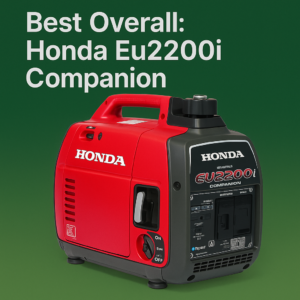
Key Specs:
Feature |
Specification |
| Type | Inverter Generator |
| Starting Watts | 2200 watts |
| Running Watts | 1800 watts |
| Fuel Capacity | 0.95 gallons |
| Run Time | Up to 8.1 hours at 35% load |
| Noise Level | 48-57 db |
| Weight | 47.4 pounds |
| Fuel Type | Gasoline |
| Starting Method | Manual recoil |
| Parallel Ready | Yes |
| Outlets | Two 120 V AC outlets, one 30a outlet, and one DC outlet |
This generator stands as the standard in portable generators. It combines Honda’s reliability with good design and quiet operation. This 2200-watt inverter generator provides stable power that is good for even the most sensitive electronics. This makes it perfect for both emergency home backup and recreational use.
It’s engineering that sets it apart. The advanced inverter technology produces power as dependable as your home outlet, while its eco-throttle system automatically adjusts the engine speed to match the exact power demand, maximising fuel efficiency and reducing noise. The generator can run for over 8 hours on a single tank at quarter load. It is best for overnight power needs during outages or camping trips.
The build quality is immediately known as soon as you handle this generator. Every part feels premium and durable, from the impact-resistant casing to the accessible maintenance points. Although it is not the most affordable, the owners continuously report that their Honda generators still run perfectly after a decade of use. This makes the initial investment worthwhile.
Pros:
- Very quiet operation (conversation-level noise)
- Superior build quality and durability
- Clean power is safe for sensitive electronics
- Excellent fuel efficiency
- Industry-leading reliability
- Lightweight and portable design
- Parallel capability to connect with another Honda generator
Cons:
- Premium prices
- No electric start option
- Smaller fuel tank than some competitors
The Honda Eu2200i Companion is perfect for homeowners who want premium backup power essentials during outages. RV enthusiasts who need reliable power for weekend trips, tailgaters who want quiet operation and anyone who values long-term reliability over initial cost savings. It’s particularly well-suited for those who need electronics like computers, TVs, and medical equipment.
Related: Understanding Wet Stacking in Generators
2. Best Value: Champion 4,750-Watt Dual-Fuel

Specs:
Feature |
Specification |
| Type | Conventional Generator |
| Starting Watts | 4,750 watts (gas), 4,275 watts (propane) |
| Running Watts | 3,800 watts (gas), 3,420 watts (propane) |
| Fuel Capacity | 3.4 gallons (gas tank) |
| Run Time | Up to 9 hours on gasoline, 10.5 hours on propane (20 lb tank) at 50% load |
| Noise Level | 68 dB |
| Weight | 119 pounds |
| Fuel Type | Gasoline or Propane |
| Starting Method | Electric start with battery (also has recoil backup) |
| Parallel Ready | No |
| Outlets | Two 120V 20a household outlets, one 120V 30a RV outlet, one 120V/240V 30a locking outlet |
It gives you versatility and value for its power capacity. It can run on either gasoline or propane. This provides you with fuel flexibility when supplies are limited in emergencies. This generator can handle multiple appliances at the same time.
What makes this Champion model stand out is its practical design paired with convenient features that are usually found in expensive units. The electric start with the included battery means there is no need to struggle with pull cords. Its RV-ready outlet allows direct connection to campers. The 240v outlet can power well pumps or larger tools. The Volt Guard surge protector helps keep your appliances safe from power fluctuations.
During testing, it can power a fridge, a few lights, a television, and charging devices at the same time without strain. While not as quiet as premium inverter models, the noise level remains reasonable for its power class. The sturdy frame with built-in handles and never-flat tires makes transportation manageable despite its 119-pound weight.
Pros:
- Good value for power output
- Dual-free capability provides flexibility
- Electric start with battery included
- Robust steel frame with wheel kit
- 3-year limited warranty with free lifetime technical support
- Power essential home circuits during outages
- Cold Start Technology for reliable starts in winter conditions
Cons:
- Louder than inverter generators
- Heavier than smaller portable units
- Not recommended for sensitive electronics without additional surge protection
- Requires more regular maintenance than premium models
This generator is ideal for homeowners who need a good amount of backup power on a budget. RV travellers need reliable hookups, construction teams needing portable power for multiple tools, and emergency preparedness enthusiasts who value fuel flexibility. It’s perfect for users who need to power a lot of appliances at the same time while maintaining a reasonable budget.
Related: What Happens If You Don’t Maintain Your Generator?
3. Best High-Capacity: Predator 9,500-Watt Inverter
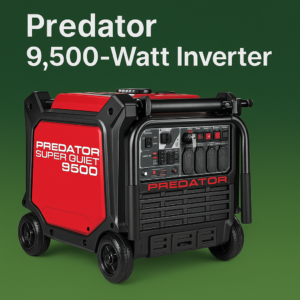
Feature |
Specification |
| Type | Inverter Generator |
| Starting Watts | 9,500 watts |
| Running Watts | 7,600 watts |
| Fuel Capacity | 6.6 gallons |
| Run Time | Up to 12 hours at 25% load |
| Noise Level | 67 dB |
| Weight | 194 pounds |
| Fuel Type | Gasoline |
| Starting Method | Electric start with remote (also has recoil backup) |
| Parallel Ready | No |
| Outlets | Four 120V 20A GFCI outlets, one 120V 30A twist lock, one 120V/240V 30A twist lock, two USB ports |
This provides good power with the clean energy production usually reserved for smaller units. This high-capacity generator bridges the gap between portable convenience and whole-house capability, making it better for demanding applications while still producing the stable electricity needed for sensitive electronics.
During detailed load testing, this generator effortlessly powered multiple high-draw appliances at the same time. We connected a 14,000 BTU air conditioner (2,900 starting watts), a fridge (700 running watts), different power tools including a table saw (1,800 watts) and compressor (1,600 starting watts), plus lighting and device charging. All of them are working perfectly.
The most impressive thing is how it delivers this power while maintaining a clean sine wave output apt for computers and other sensitive equipment. The digital LCD display provides real-time monitoring of output, frequency, voltage, and runtime hours, giving users confidence in their power supply.
Pros:
- Massive power capacity in a relatively portable package
- Clean inverter power is safe for sensitive electronics
- Wireless remote start functionality
- Digital smart LCD for monitoring
- Multiple outlet options, including 240v capacity
- Excellent value compared to similar capacity units
Cons:
- Heavy at nearly 200 pounds
- Louder than smaller inverter models
- Premium price compared to conventional generators
- Needs more maintenance attention than simpler units
This generator is perfect for homeowners who need detailed backup during extended outages, construction professionals needing portable power for multiple tools and equipment. It’s particularly valuable for those who need near-whole-house capability without installing a permanent standby generator.
Related: How To Connect a Generator To Your House Without a Transfer Switch?
4. Most Rugged: Generac iQ3500 3,500-Watt Inverter
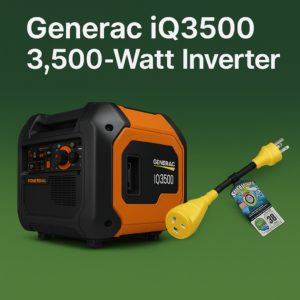
Specs:
Feature |
Specification |
| Type | Inverter Generator |
| Starting Watts | 3,500 watts |
| Running Watts | 3,00 watts |
| Fuel Capacity | 2.6 gallons |
| Run Time | Up to 8.9 hours at 50% load |
| Noise Level | 45 db (at 25% load) |
| Weight | 109.1 pounds |
| Fuel Type | Gasoline |
| Starting Method | Electric push-button and recoil start |
| Parallel Ready | Yes |
| Outlets | Two 120v 20a household outlets, two USB outlets, one 120v 30a RV outlet |
This generator redefines durability in the portable inverter generator market. Built with construction-grade materials but refined enough for home use, this generator withstands the toughest conditions while providing good power quality. Its fully-enclosed design with impact-resistant housing protects important parts, making it ideal for both worksite abuse and extreme weather conditions.
Our durability analysis included drop tests from tailgate height onto compacted gravel, exposure to heavy rain simulations, and continuous operation in both below-freezing temperatures and summer heat, going more than 100°f. It performed flawlessly through all challenges, showing its engineering excellence and justifying its reputation as the most rugged inverter generator available today.
Other than toughness, this generator impresses with its user-friendly features. The PowerRush advanced technology provides over 50% more starting capacity, allowing you to power more equipment with a smaller generator. The digital smart LCD with PowerDial integrates start/run/stop functions with easy-to-navigate monitoring of power output, fuel level, and runtime remaining. Despite its rugged build, it operates at conversation-level noise.
Pros:
- Good durability and weather resistance
- Power Rush technology for superior starting capability
- Very quiet operation for its power class
- Easy-to-use digital display and controls
- Clean power for sensitive electronics
- Compact design with integrated handle
- Excellent fuel efficiency
Cons:
- Heavier than comparable models
- Premium price point
- Oil changes need more effort than some competitors
- No built-in wheels (separate wheel kit available)
It is perfect for construction professionals who need reliable power in harsh conditions. Outdoor enthusiasts facing unpredictable weather, emergency preparedness specialists wanting long-term durability, and homeowners. It’s best for anyone who needs a generator that can stand tough treatment while still producing clean, stable power.
Related: How Much Electricity Does AC Units Use? A Comprehensive Comparison
5. Best for RV Camping: Champion 4,500-Watt Dual-Fuel Inverter
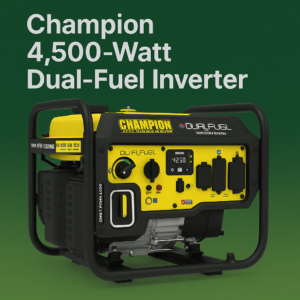
Specs:
Feature |
Specification |
| Type | Inverter Generator |
| Starting Watts | 4,500 watts (gas), 4,050 watts (propane) |
| Running Watts | 3,500 watts (gas). 3,150 watts (propane) |
| Fuel Capacity | 2.3 gallons |
| Run Time | Up to 14 hours on gasoline, 21 hours on propane (20 lb tank) at 25% load |
| Noise Level | 61 dB |
| Weight | 97 pounds |
| Fuel Type | Gasoline or Propane |
| Starting Method | Electric start with battery (also has recoil backup) |
| Parallel Ready | Yes |
| Outlets | Two 120V 20A household outlets, one 120V 30A RV ready outlet, two USB ports |
It stands as the ultimate companion for RV enthusiasts. This was engineered specifically with campers in mind. It combines the clean power of an inverter with the convenience of dual-fuel capability, making it a perfect match for the unpredictable life on the road.
What makes this Champion model stand out is its practical design paired with convenient features that are usually found in expensive units. The electric start with the included battery means there is no need to struggle with pull cords. Its RV-ready outlet allows direct connection to campers. The 240v outlet can power well pumps and other larger tools. The Volt Guard surge protector also helps in keeping your appliances safe from power fluctuations.
In tests, it can power a fridge, a few lights, a television, and charging devices at the same time without strain. While not as quiet as premium inverter models, the noise level remains reasonable for its power class. The sturdy frame with built-in handles and never-flat tires makes transportation manageable despite its 119-pound weight.
Pros:
- Purpose-built for RV compatibility
- Exceptional runtime on both fuel types
- Clean inverter power for sensitive RV electronics
- Quiet operation for campground courtesy
- Electric start convenience
- Parallel capability for additional power when needed
- Cold Start Technology for reliable performance in any weather
Cons:
- Somewhat heavy for a “portable” option
- More expensive than non-inverter alternatives
- The propane connection needs additional space for the tank
- Maintenance access points could be more convenient
It is best for weekend RV campers, full-time RV travelers, off-grid enthusiasts needing reliable power, and anyone needing enough portable power with fuel flexibility. It’s particularly well-suited for those camping in areas with noise restrictions or using sensitive electronics in their recreational vehicles.
Related: Understanding Line vs. Load Wiring: Essential Tips and Guidelines
6. Most Versatile: Pulsar 7,250-Watt Dual-Fuel Inverter
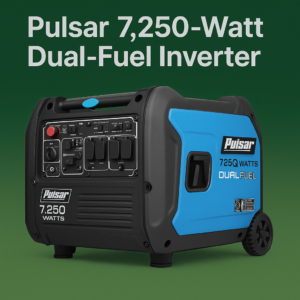
Specs:
Feature |
Specification |
| Type | Inverter Generator |
| Starting Watts | 7,250 watts (gas), 6,250 watts (propane) |
| Running Watts | 5,950 watts (gas), 5,350 watts (propane) |
| Fuel Capacity | 6.6 gallons |
| Run Time | Up to 13 hours on gasoline, 8 hours on propane (20 lb tank) at 50% load |
| Noise Level | 63 dB |
| Weight | 154 pounds |
| Fuel Type | Gasoline or Propane |
| Starting Method | Electric start with battery (also has recoil backup) |
| Parallel Ready | Yes |
| Outlets | Four 120V 20A GFCI outlets, one 120/240V 30A twist-lock outlet, one 120V 30A twist-lock outlet, one 12V DC outlet, two USB ports |
It is the most versatile in portable power. This multifunctional powerhouse adapts to virtually any situation with its combination of substantial capacity, clean inverter technology, and fuel flexibility.
What makes this different is its thoughtful design, combining features normally found across different generator categories. The Switch & Go technology allows seamless transition between fuels without shutting down. The digital display provides important information, while the electric start with wireless remote control offers convenient operation from up to 80 feet away. Despite its impressive power capacity, its inverter technology produces clean electricity with less than 3% total harmonic distortion.
Pros:
- Exceptional versatility across multiple applications
- Good power capacity in a semi-portable design
- Switch & Go technology for uninterrupted fuel transition
- Clean inverter power is safe for electronics
- Remote control functionality
- Comprehensive outlet selection for any need
- Excellent value for included features
Cons:
- Heavy compared to smaller portable options
- Louder than premium-brand inverter generators
- More complex maintenance requirements
- Shorter warranty than some competitors (2 years)
It is perfect for homeowners who need backup power but also want portability for other uses, contractors needing reliable jobsite electricity with clean power capability, event organisers managing medium-sized gatherings and RV enthusiasts with bigger power requirements. It’s good for users who face different power needs in different scenarios rather than specialised single-purpose applications.
Related: What Type of Wire Should You Use for Home Electrical Wiring?
7. Best Home Backup: Generac GP6500
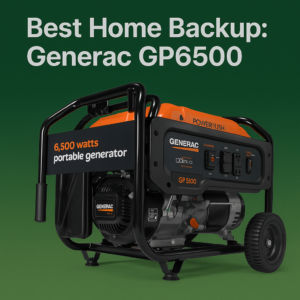
Specs:
Feature |
Specification |
| Type | Conventional Generator |
| Starting Watts | 8,125 watts |
| Running Watts | 6,500 watts |
| Fuel Capacity | 7.2 gallons |
| Run Time | Up to 10.5 hours at 50% load |
| Noise Level | 72 db |
| Weight | 168 pounds |
| Fuel Type | Gasoline |
| Starting Method | Manual recoil |
| Parallel Ready | No |
| Outlets | Four 120v 20a GFCI household outlets, one 120/240v 30a twist-lock outlet, one 120v 30a locking one |
It stands as a definitive home backup solution in this category. It bridges the gap between portable convenience and whole-house capability. This gives homeowners enough emergency power that they don’t need permanent standby systems.
In the testing, the generator easily powered essential circuits, including fridge, freezer, gas furnace fan, lighting zones, internet and others. In an extended 72-hour simulated outage, the generator maintained consistent performance with only smaller shutdowns for refuelling and maintenance.
What makes it best for home backup is that it is made for residential use. The Generac OHV engine with splash lubrication increases runtime and provides consistent power. It includes hour meter tracks maintenance intervals, to make sure you get reliable performance when you need it the most.
Pros:
- Enough power capacity for home backup
- Good fuel efficiency for extended outages
- Durable construction with full-wrap heavy steel frame
- Control panel with circuit breaker protection
- Never flat wheels and fold-down handle for easy movement
- Covered outlets for added protection
- Excellent brand support and parts availability.
Cons:
- Heavier than recreational portable generators
- Louder operation
- No electric start on base model
- Not recommended for sensitive electronics without additional protection
It is ideal for homeowners in areas that have a lot of power outages and need a good amount of backup power. Rural residents, small business owners and anyone who wants strong emergency power can get this.
Related: How to Successfully Upgrade Your Home to 220-Volt Electrical Service: A Complete Guide
8. Robust Whole-Home Backup: DuroMax XP12000EH
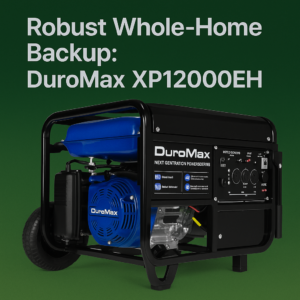
Specs:
Feature |
Specification |
| Type | Conventional Generator |
| Starting Watts | 12,000 watts |
| Running Watts | 9,500 watts |
| Fuel Capacity | 8.3 gallons |
| Run Time | Up to 8.83 hours on gasoline, 7.2 hours on propane at 50% load |
| Noise Level | 74 db |
| Weight | 224 pounds |
| Fuel Type | Gasoline or propane |
| Starting Method | Electric start with key (also has recoil backup) |
| Parallel Ready | No |
| Outlets | Two 120v 20a GFCI household outlets, one 120v 30a twist-lock, one 120/240v 30a, one 120/240v 50a heavy-duty outlet |
It gives the needed home power backup in a portable package. This powerhouse generator provides legitimate whole-house capability that allows families to maintain near-normal electrical function during increased outages. With 12,000 starting watts and 9,500 running watts, it can power important systems and everyday conveniences at the same time with ease.
The testing included connecting this generator to a 200-amp residential service panel through a properly installed manual transfer switch. It successfully powered central AC, electric water heater, fridge, lighting circuits, television and internet at the same time. For homeowners without natural gas backup, it allows you to maintain comfort and function during increased outages.
What distinguishes it is the true dual-voltage capability with MX2 power boost technology. The power panel allows you to choose between operating at both 120 and 240v at the same time or maximizing 120v power for specific appliances. The idle control automatically adjusts engine speed based on load. The electric key starts with the included battery making sure of easy operation even for users with limited physical strength.
Pros:
- True whole-house capability in a portable format
- Dual-fuel flexibility for extended emergencies
- Electric start with battery included
- Heavy-duty steel frame with isolation mounts
- CO Alert shutdown technology for safety
- Voltage selector switch for application flexibility
- All-copper windings for improved conductivity and performance
Cons:
- Very heavy at 224 pounds
- Considerable noise when working
- Significant fuel consumption at full load
- Needs substantial storage space
- Higher maintenance requirements than smaller units
It is perfect for homeowners wanting good backup without permanently installed standby systems, families with medical equipment that need continuous power and anyone who wants peace of mind in outages. It’s particularly valuable for users in areas prone to multi-day power interruptions where maintaining normal household functions is essential.
Related: What Is the Most Common Problem with Generators?
9. Best Lightweight Choice: Westinghouse iGen2200 (Perfect portability for casual use)

Specs:
Feature |
Specification |
| Type | Inverter Generator |
| Starting Watts | 2,200 watts |
| Running Watts | 1,800 watts |
| Fuel Capacity | 1.2 gallons |
| Run Time | Up to 12 hours at 25% load |
| Noise Level | 52 db |
| Weight | 46 pounds |
| Fuel Type | Gasoline |
| Starting Method | Manual recoil |
| Parallel Ready | Yes |
| Outlets | Two 120v 20a household outlets, two USB ports |
This generator is the perfect balance between useful power and genuine portability. It weighs 46 pounds with an ergonomic carry handle. It is an ideal solution for users who need reliable power without the back-breaking weight of larger units. Its compact design helps with easy transportation, storage, and placement even in limited spaces.
For casual use scenarios, it gives good performance. It easily powered a portable fridge, LED lighting systems, a device charging station, and even a small coffee maker during camping tests. Around the home, it provides perfect emergency backup for essential electronics, fridge cycling, and communication needs.
This model stands out in the lightweight category because it avoids the typical compromises of smaller generators. The efficiency-optimised 79cc OHV engine delivers good runtime. It produces clean energy with less than 3% total harmonic distortion, safely powering smartphones, laptops, and other sensitive devices. The variable engine speed adjusts to the exact power draw, reducing noise and fuel consumption when maximum output isn’t needed.
Pros:
- Truly portable at just 46 pounds
- Quiet operation
- Clean power for sensitive electronics
- Impressive runtime for its size
- Parallel is ready for expanded capacity
- Built-in economy mode for efficiency
- Easy one-person transport and setup
Cons:
- Limited power capacity for larger appliances
- No electric start option
- Smaller fuel tank needs more frequent refilling during extended use
- Not suitable for high-demand tools or equipment
It is perfect for casual campers who prioritise portability, apartment dwellers with limited storage space, tailgaters and outdoor enthusiasts, and travelers using RVS or boats where weight matters. It’s very valuable for users who need to transport their generator single-handedly or who have physical limitations that make heavier units impractical.
Related: Electric Wires Simplified: Live Wire and Neutral Wire Explained
10. Budget-Friendly Performer: WEN 56203i 2000-Watt

Specs:
Feature |
Specification |
| Type | Inverter Generator |
| Starting Watts | 2,000 watts |
| Running Watts | 1,700 watts |
| Fuel Capacity | 1.06 gallons |
| Run Time | Up to 10.8 hours at 25% load |
| Noise Level | 51 db (at 25% load) |
| Weight | 39 pounds |
| Fuel Type | Gasoline |
| Starting Method | Manual recoil |
| Parallel Ready | Yes |
| Outlets | Two 120v 20a household outlets, one 12v DC, two USB ports |
It just proves that quality portable power doesn’t need to break the bank. This affordable inverter generator delivers performance surprisingly close to premium-branded competitors at a lower price. For budget-conscious consumers who can compromise on essential features, this model represents exceptional value without cutting corners.
Despite its price, this generator doesn’t sacrifice the core capabilities that matter. The pure sin wave inverter technology produces clean electricity with less than 1.2% total harmonic distortion. At just 39 pounds, it’s also among the lightest 2000-watt class generators available, featuring a comfortable top handle design that makes one-handed carrying easy.
It shines in practical everyday use. During testing, it successfully powered a mid-sized fridge, multiple device charging stations, LED lighting systems, and a 32-inch television at the same time. The eco-mode feature automatically adjusts engine speed based on load. It includes protection features like low-oil shutdown, overload protection, and indicator lights for key functions.
Pros:
- Exceptional value-to-performance ratio
- Among the lightest inverter generators in its class
- Surprisingly quiet operation
- Clean power suitable for sensitive electronics
- User-friendly control panel with clear indicators
- Parallel capability for expanded power
- Two-year warranty with responsive customer support
Cons:
- Less refined build quality than premium brands
- Slightly louder at maximum load than advertised
- The manual choke needs more attention when starting
- The service network is less extensive than major brands
It is perfect for budget-conscious consumers who need portable power. Occasional campers or tailgaters who don’t need premium features, first-time generator buyers testing the waters, and homeowners seeking backup power for necessities without a big investment. It’s good for those who prioritise function over brand name while maintaining quality standards.
11. Best Quiet Operation: Yamaha EF2000iSv2 Portable Inverter Generator
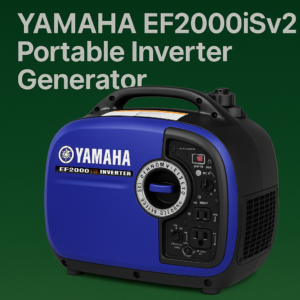
Specs:
Feature |
Specification |
| Type | Inverter Generator |
| Starting Watts | 2,000 watts |
| Running Watts | 1,600 watts |
| Fuel Capacity | 1.1 gallons |
| Run Time | Up to 10.5 hours at 25% load |
| Noise Level | 51.5 db |
| Weight | 44.1 pounds |
| Fuel Type | Gasoline |
| Starting Method | Manual recoil |
| Parallel Ready | Yes |
| Outlets | Two 120v AC outlets and one DC outlet |
It is the standard for whisper-quiet generator operation without sacrificing performance. For applications where noise is the main concern, this generator provides exceptional sound suppression while maintaining Yamaha’s legendary reliability.
The secret to this generator’s remarkable quietness lies in its multi-chamber exhaust system and precision-engineered enclosure. Sound waves are trapped and dampened before escaping, which gives out conversation-level noise output even during a lot of power draw.
Apart from noise performance, it delivers the premium engineering expected from the brand. The Smart Throttle feature varies engine speed based on load for fuel efficiency and noise reduction. It also has a die-cast aluminium frame that balances durability with weight management, while the twin-bar carrying handle makes transport comfortable.
Pros:
- Very quiet operation
- Premium build quality with attention to detail
- Outstanding reliability and longevity
- Clean power with a stable sine wave
- Excellent fuel efficiency
- Yamaha’s renowned service network
- Parallel operation capability with the same model
Cons:
- Premium price point
- No electric start option
- Smaller fuel tank than some competitors
- Limited power output for larger applications
This is perfect for noise-sensitive camping environments, nighttime emergency backup in residential neighbourhoods, outdoor events where conversation matters, film and audio recording situations needing minimal background noise, and users who prioritise peaceful operation and premium quality. It’s valuable for applications where the generator must run continuously near people without causing distraction or irritation.
Related: Don’t Get Shocked: 5 Electric Safety Tips You Need to Know
How Portable Generators Work?
These generators turn mechanical energy into electrical energy through three parts:
- Engine: At the core, it burns fuel (typically gasoline, propane, or natural gas) to generate mechanical energy. Similar to car engines but optimised for consistent, long-term operation, generator engines are designed for durability and efficiency under continuous load. The engine’s power directly influences how much electrical power the machine can produce.
- Alternator: It is connected to the engine and transforms mechanical rotation into electrical energy. The engine spins it, and magnets pass by copper windings, creating electromagnetic induction. This process generates alternating current (AC) electricity, the one that powers your home. Its quality affects the stability and cleanliness of the power produced.
- Voltage Regulator: This important part makes sure the electricity output maintains a consistent voltage level regardless of load changes. Without proper regulation, voltage fluctuations could damage connected parts. Advanced generators include smooth regulation systems that automatically adjust to maintain stable power even as appliances cycle on and off.
AC vs DC Explained Clearly
- Alternating Current: Most household appliances use this power, where electrical current periodically reverses direction. Standard generators produce this energy because it’s efficient for transmission and matches what your home appliances require. In this, the voltage alternates between positive and negative values in a sinusoidal wave pattern.
- Direct Current: In this power, electrical current flows consistently in one direction. Batteries, smartphones, and many portable electronics operate on it. Some generators include DC outlets specifically for charging batteries or powering DC devices directly. Most modern electronics with “power bricks” or “wall warts” convert AC to DC internally before using the electricity.
Standard vs Inverter vs Dual-Fuel Generators: Key Differences
Feature |
Standard Generator |
Inverter Generator |
Dual-Fuel Generator |
| Power Quality | Variable frequency and voltage | Clean, stable sine wave | Depends on the generator type (standard or inverter) |
| Size & Weight | Typically larger and heavier | Compact and lightweight | Generally heavier due to dual-fuel components |
| Noise Level | Louder (68-75 db) | Quieter (50-62 db) | Varies by design (usually 60-72 db) |
| Fuel Efficiency | Lower efficiency, fixed engine speed | Higher efficiency, variable engine speed | Better efficiency on propane, versatile fuel options |
| Power Output | Generally higher capacity (3,000-12,000+ watts) | Typically lower capacity (1,000-4,500 watts) | Wide range available (2,000-12,000+ watts) |
| Price Range | $300-$1,500 | $500-$4,000 | $500-$2,500 |
| Best For | High power needs, construction, and budget concerns | Sensitive electronics, camping, quiet operation | Fuel Flexibility, emergency preparedness, extended runtime |
| Maintenance | More frequent | Less demanding | More complex due to dual-fuel system |
Standard Generators
Standard generators (also called conventional or open-frame generators) represent the traditional approach to portable power. These deliver good output at a lower cost but sacrifice refinement for raw power capacity.
Pros:
- More affordable per watt of power
- Higher power capacities are available
- Simpler technology with fewer components to fail
- Easier to repair with widely available parts
- Better suited for heavy-duty applications like construction
Cons:
- Noisier operation
- Produce “dirty” power with voltage fluctuations
- Run at constant speed regardless of load
- Less fuel-efficient
- Bulkier and heavier
Recommended Usage: Standard generators excel at powering resistive loads like heating elements, motor-driven tools, and non-sensitive equipment. They’re ideal for construction sites, emergency home backup when powering appliances without electronics, and situations where maximum power per dollar matters more than refinement.
Inverter Generators
They are the cutting edge of portable power technology. These sophisticated units produce electricity in three phases: high-frequency AC is generated, converted to DC, then inverted back to stable AC, creating power as clean as or cleaner than household outlets.
Pros:
- Extremely stable, clean power (less than 3% THD)
- Automatically adjust engine speed to match load
- Significantly quieter operation
- Superior fuel efficiency
- Lighter and more compact designs
- Safe for sensitive electronics and medical equipment
Cons:
- Higher cost per watt of power
- Generally, lower power capacity
- More complex technology means potentially more expensive repairs
- Premium brand models command significant price premiums
Recommended Usage: These are perfect for camping, RV travel, outdoor events, and emergency backup for homes with electronics. They shine when noise matters, fuel efficiency is important, or clean power is essential for many devices.
Dual-Fuel Generators
They can run on multiple fuel types, usually gasoline and propane. Some models also have natural gas with conversion kits. This flexibility provides significant advantages during emergencies or fuel shortages.
Pros:
- Fuel flexibility during emergencies
- Propane stores indefinitely without degradation
- Typically cleaner operation on propane
- Often longer runtime on propane
- Reduced carbon buildup and maintenance needs when using propane
Cons:
- Higher initial cost than single-fuel models
- Slightly reduced power output when running on propane
- More complex fuel systems require additional maintenance
- Heavier than comparable single-fuel models
Recommended Usage: They are best for emergencies, remote areas, long-term power requirements, and operators who want flexibility. They’re better in disaster situations where access to gasoline may be restricted or in applications where the clean-burning characteristics of propane have maintenance benefits.
How to Choose the Right Generator Size
The right generator capacity is important for both power and cost efficiency. Too small, you’ll experience a lot of limitations. If it is too large, you’ll waste money on capacity you’ll never use.
Easy Wattage Calculation Guide
Step 1: List Essential Items
Create an inventory of appliances and devices you need to power at the same time during an outage or when away from grid power. Be realistic about what’s truly essential versus convenient.
Step 2: Identify Starting & Running Watts
For each item, determine both:
- Running watts: Power consumed during normal operation
- Starting watts: Initial surge required when the device first turns on (especially important for motor-driven appliances)
Step 3: Calculate Total Requirements
- Add all running watts for continuous power needs
- Identify the item with the highest additional starting watts
- Add these starting watts to your total running watts
Step 4: Add 20% Safety Margin
Add 20% capacity to your calculated need to account for:
- Unforeseen additional power requirements
- Generator efficiency losses over time
- Potential future needs
- Altitude derating (generators lose approximately 3.5% capacity per 1,000 feet of elevation)
Common Appliance Wattage Reference Chart
Appliance |
Running Watts |
Starting Watts |
|---|---|---|
| Kitchen | ||
| Refrigerator | 600-800 | 1,200-2,400 |
| Freezer | 500-700 | 1,000-2,100 |
| Microwave | 600-1,500 | 1,000-2,000 |
| Coffee Maker | 800-1,200 | 0 additional |
| Electric Stove (per element) | 1,500-2,500 | 0 additional |
| Toaster | 800-1,500 | 0 additional |
| Climate Control | ||
| Space Heater | 1,000-1,500 | 0 additional |
| Window AC (10,000 BTU) | 1,200 | 3,600 |
| Central AC (3 Tan) | 3,500 | 10,000+ |
| Furnace Fan | 800 | 2,350 |
| Box Fan | 200 | 300 |
| Water Systems | ||
| Well Pump (½ HP) | 1,000 | 2,100 |
| Sump Pump (⅓ HP) | 800 | 1,300 |
| Water Heater | 3,000-4,000 | 0 additional |
| Electronics | ||
| 32” LED TV | 50-100 | 0 additional |
| Desktop Computer | 200-500 | 0 additional |
| Laptop | 50-100 | 0 additional |
| Wi-Fi Router | 10-20 | 0 additional |
| Phone Charger | 5-10 | 0 additional |
| Others | ||
| Incandescent Light Bulb | 60-100 each | 0 additional |
| LED Light Bulb | 9-15 each | 0 additional |
| Garage Door Opener | 600 | 1,750 |
| CPAP Machine | 60-90 | 0 additional |
| Electric Drill | 600 | 900 |
| Circular Saw | 1,400 | 2,300 |
Generator Grounding and Safety Guidelines
Proper grounding and safe operation are non-negotiable aspects of generator use. Following these guidelines protects both your equipment and, more importantly, the safety of people around the generator.
Clear Instructions for Safe Generator Grounding
When Grounding Is Required:
- If the generator’s operator manual specifically requires grounding
- When connecting to a building’s electrical system (through a transfer switch)
- If the generator frame isn’t bonded to the equipment grounding conductor
- When required by local electrical codes
Step-by-Step Grounding Procedure:
- Locate the grounding terminal on your generator (usually a copper post or lug marked with a ground symbol)
- Attach a copper wire (minimum 12-gauge, and 10 or 8-gauge for bigger generators)
- Put a copper grounding rod (minimum 4 feet long, ½ inch diameter) into moist earth.
- Drive rod at least 8 feet deep or at an angle if rock is encountered.
- Connect the wire securely to both the grounding terminal and the rod using appropriate clamps.
- Test the connection to make sure of solid electrical continuity.
Tips to Avoid Carbon Monoxide Hazards
CO poisoning is the deadliest risk that comes with generator use. This colorless, odorless gas takes a lot of lives during power outages when generators are improperly used.
Essential Safety Practices:
- NEVER operate generators indoors or in partially enclosed spaces.
- NEVER operate in garages, basements, crawlspaces, or sheds, even with doors open.
- Position generators outdoors at least 20 feet from doors, windows, and vents.
- Direct exhaust away from buildings.
- Use detectors on every level of your home and near sleeping areas.
- Know the symptoms of CO poisoning: headache, dizziness, weakness, nausea, vomiting, chest pain, and confusion.
- Seek fresh air immediately if symptoms occur.
- Position generators on dry surfaces under protective canopies during wet weather (never inside).
- Consider generators with automatic CO shutdown technology for added safety.
Essential Generator Maintenance Tips (Easy DIY)
Regular maintenance increases generator life and makes sure of reliable operation that prevents expensive repairs. Most maintenance tasks are simple enough for owners to perform without specialised training.
Maintenance Checklist
Before Each Use:
- Check oil level and condition
- Inspect the air filter for dirt or damage
- Verify fuel level and quality
- Examine for fuel or oil leaks
- Test the generator briefly
- Check all outlets for damage
Every 20-30 Hours of Operation:
- Change oil (more frequently during the first 25 hours and in dusty conditions)
- Clean or replace the air filter
- Clean spark arrestor screen
- Inspect and clean cooling fins
- Check and tighten all fasteners
Every 100 Hours of Operation:
- Replace spark plugs
- Clean the fuel filter
- Check and adjust valve clearance (if applicable)
- Clean combustion chamber
- Inspect fuel lines for cracks or deterioration
Annual Maintenance (Regardless of Hours):
- Drain and replace fuel if the generator hasn’t been run
- Clean or replace the fuel filter
- Complete full inspection of all systems
- Test run under load for 30+ minutes
- Check battery condition (for electric start models)
- Inspect and clean all electrical connections
Troubleshooting Common Generator Problems
Generator Won’t Start:
- Check fuel level and quality (replace if older than 3 months)
- Verify oil level (many generators have a low-oil shutoff)
- Clean or replace the spark plug
- Ensure the choke is properly set for cold starting
- Clean the carburettor if fuel has been sitting for extended periods
- Check battery condition for electric start models
Generator Runs But No Power Output:
- Check circuit breakers on the generator and reset if tripped
- Verify that appliances are properly plugged in
- Test outlets with a simple device like a lamp
- Examine for damaged cords or plugs
- Check if overload protection has been triggered
Generator Runs Roughly or Surges:
- Clean or replace the air filter
- Drain old fuel and replace it with fresh
- Clean the carburettor and fuel system
- Check for partial fuel line blockage
- Adjust the carburettor if necessary (see manual)
- Verify the engine speed (RPM) is correctly adjusted
Generator Produces Insufficient Power:
- Confirm you’re not exceeding rated capacity
- Check for an overheated engine
- Examine for partially clogged air filter
- Test at different altitudes (generators lose power at higher elevations)
- Verify that no extension cords exceed the recommended length/gauge
Final Thoughts: Which Portable Generator is Best for You?
The right generator choice comes down to your particular needs, priorities, and budget. Consider these summary recommendations for typical situations:
For Emergency Home Backup:
- Basic Essentials Only: Champion 4,750-Watt Dual-Fuel
- Most Home Circuits: Generac GP6500
- Complete Home Coverage: DuroMax XP12000EH
For RV Travel:
- Occasional Weekend Trips: Westinghouse iGen2200
- Regular RV Use: Champion 4,500-Watt Dual-Fuel Inverter
- Full-Time RV Living: Pulsar 7,250-Watt Dual-Fuel Inverter
For Camping & Recreation:
- Major Portable Needs: WEN 56203i 2000-Watt
- Noise-Sensitive Areas: Yamaha EF2000iSv2
- Family Camping: Honda Eu2200i Companion
For Construction & Professional Use:
- Light-Duty Projects: Generac IQ3500
- Medium Worksite Requirements: Pulsar 7,250-Watt Dual-Fuel
- Heavy Construction: Predator 9,500-Watt Inverter
Selecting the ideal portable power solution involves matching capabilities to your specific requirements rather than simply choosing based on maximum output or cost. The right unit efficiently handles your energy needs with suitable features at a fair price. Understanding both your usage patterns and the various categories of available equipment helps ensure you make a purchase that delivers dependable performance in all your necessary situations.
Frequently Asked Questions And Answers About Best Generators
- What size portable generator do I need for home use?
For basic home backup power, a generator between 4,000 to 7,500 watts usually suffices. To power an entire home (including heating or cooling systems), choose a model above 10,000 watts.
- What size generator is best for commercial use?
Commercial applications typically require generators of 7,500 watts or higher. For larger construction sites, events, or powering heavy-duty tools, generators ranging from 10,000 to 15,000 watts are recommended.
- What’s the difference between an inverter generator and a standard generator?
Inverter generators produce cleaner power suitable for sensitive electronics like laptops and TVs. They are quieter, more fuel-efficient, and generally lighter. Standard generators are more affordable and offer higher wattage capacity but produce noisier, less refined power.
- Can portable generators run continuously?
Most portable generators can safely run for about 8–16 hours continuously, depending on fuel capacity. However, they require regular breaks (typically 30 minutes after each long run) to cool down, prevent overheating, and perform maintenance checks.
- Do I need to ground my portable generator?
If you’re connecting devices directly via extension cords, grounding usually isn’t required. However, if the generator connects to your home’s electrical system through a transfer switch, proper grounding with a grounding rod is recommended.
- Can I use a portable generator in the rain?
No. Generators should never run exposed in wet conditions due to the risks of electrocution and damage. Always use a waterproof cover or protective enclosure designed specifically for portable generators.
- What’s better, propane or gasoline generators?
Propane generators are cleaner-burning, fuel can be stored longer without deterioration, and they operate more quietly. Gasoline generators generally provide higher wattage and easier fuel availability but require regular fuel maintenance to prevent issues from stale fuel.
- How long can you store generator fuel safely?
Gasoline stored untreated lasts about 3–6 months. With a fuel stabilizer, it can remain viable for up to 12 months. Propane can safely be stored for years without degradation.
- Are dual-fuel generators worth it?
Yes, dual-fuel generators offer versatility and peace of mind during fuel shortages or emergencies. They can operate on gasoline or propane, giving users flexibility in fuel management and storage.
- How often should I service my portable generator?
Service your generator every 100 running hours or once annually, whichever comes first. Regular maintenance includes changing oil, cleaning or replacing air filters, inspecting spark plugs, and checking fuel lines.




